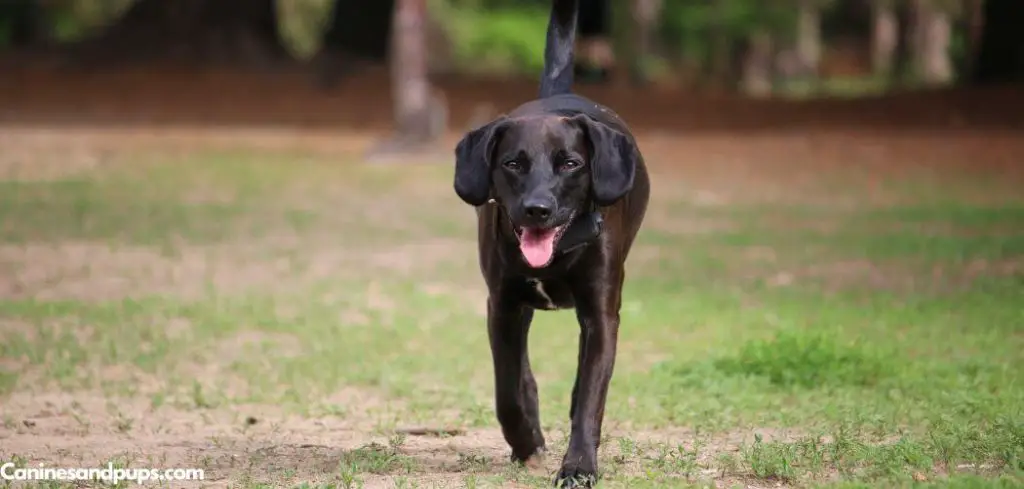Dogs panting while running around is often a normal part of their behavior, but it can sometimes signal stress or an underlying health issue.
While panting is a natural way for dogs to regulate body temperature, excessive or unusual panting combined with hyperactive behavior can be concerning.
We outline the common reasons for panting and running around in dogs, what you can do at home, and when to seek veterinary help.
Dog Panting and Running Around — Why It Happens
Dog panting and running around often happen when a dog is overexcited, anxious, or trying to release excess energy. Panting is the body’s natural way of cooling down and regulating temperature after bursts of activity, but when it occurs alongside restless running, it can also point to emotional stress, fear, or overstimulation.
Environmental triggers like loud noises, visitors, or changes in routine can make a dog act this way.
However, if the behavior seems excessive or happens without a clear reason, it may indicate an underlying medical issue or anxiety disorder that requires a vet’s assessment.

Dog Panting and Running Around: Common Causes
Normal Physical Activity
Panting while running is often a natural response to physical exertion. Dogs regulate their body temperature primarily through panting, so when they run or play vigorously, increased airflow helps cool them down.
Most dogs return to normal breathing after a short rest, and their panting is accompanied by energetic behavior.
Recognizing the difference between normal exercise-induced panting and excessive panting is key for dog owners.
Read more: Dog Panting and Following Me Around (Here’s why)
Heat or Overexertion
Excessive panting during running can indicate overheating or overexertion. Dogs are susceptible to heat stress, especially in warm weather, thick-coated breeds, or when running on hot surfaces.
Signs of heat-related issues may include drooling, lethargy after activity, red gums, or uncoordinated movements. Immediate cooling and hydration are critical to prevent heatstroke, which can be life-threatening.
Anxiety or Excitement
Some dogs pant and run around due to anxiety or high excitement. Panting is a physiological response to increased stress hormones, while running may serve as an outlet for nervous energy.
Dogs may exhibit pacing, barking, or repetitive movements. These behaviors can be more pronounced in puppies, newly adopted dogs, or in unfamiliar environments.
Pain or Discomfort
Dogs may pant and run around when experiencing pain or discomfort. Panting can be a sign of stress or internal distress, and restlessness may indicate that the dog is trying to cope with discomfort.
This could be caused by gastrointestinal issues, musculoskeletal pain, or other medical conditions. Owners should observe for limping, whining, or other unusual behaviors that suggest pain.
Heart or Respiratory Issues
Panting combined with hyperactive behavior could sometimes indicate heart or respiratory problems. While activity-induced panting is normal, excessive panting disproportionate to exertion can signal cardiovascular strain or breathing difficulties.
Other signs may include coughing, difficulty breathing, rapid heartbeat, or fatigue after minimal activity. Early veterinary evaluation is essential to rule out serious conditions.
Hyperthyroidism or Metabolic Disorders
Metabolic conditions such as hyperthyroidism can lead to increased energy and panting.
Dogs with overactive thyroid glands may display hyperactivity, restlessness, and excessive panting even with moderate activity.
Weight loss, increased appetite, and behavioral changes are additional indicators. Diagnosis requires blood tests and proper management to control symptoms.
What to Do If Your Dog Is Panting and Running Around
Ensure your dog has a safe environment to run and expend energy without risk of overheating or injury. Provide access to fresh water and shaded areas, especially during warm weather or outdoor play.
Monitor your dog’s breathing and behavior after activity. If panting is excessive or accompanied by distress, allow your dog to rest in a cool area and offer hydration.
Establish consistent routines for exercise to manage hyperactivity and reduce anxiety-induced panting. Gentle training, interactive play, and mental stimulation can help channel energy appropriately.
Observe for signs of pain or discomfort and limit strenuous activity if your dog appears unwell. Maintaining a balance between exercise and rest is key for healthy behavior.
When to Call or Visit Your Vet
Seek veterinary attention if you notice:
Panting that is excessive, persistent, or disproportionate to activity
Coughing, wheezing, or labored breathing alongside running
Collapse, disorientation, or fatigue after mild activity
Behavioral changes suggesting pain, anxiety, or restlessness
Rapid heartbeat, pale gums, or other signs of cardiovascular or metabolic distress
Veterinarians can perform a physical exam, blood work, and diagnostic tests to determine underlying medical causes and recommend appropriate interventions.
Read more: Dog Panting and Moving Around at Night (Here’s why)
Key Takeaway
Panting while running around is often normal, reflecting a dog’s need to regulate body temperature and expend energy. However, when panting is excessive, persistent, or paired with unusual behavior, it may indicate stress, medical conditions, or overheating.
Providing a safe, comfortable environment, observing your dog’s behavior, and seeking veterinary guidance when needed ensures your dog remains healthy, happy, and energized without risk of serious complications.
